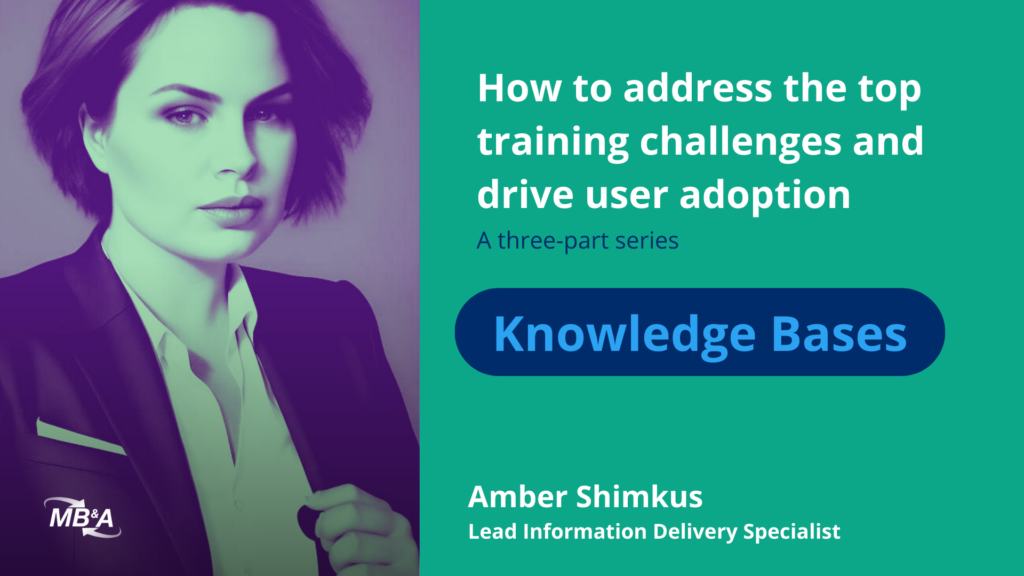Challenge 2: You don’t know what kind of training content to create
In the first article in this series, you received an overview of knowledge bases – why you should have one, and how it might be created and maintained. The next challenge to tackle after creating your knowledge base is creating engaging and effective training content.
Consider Adult Learning Styles
Humans are all good at different things, and we all have distinct learning styles that we carry with us into adulthood and our working lives. Think back to your school friends. Did you have the “vocabulary sponge” friend who breezed through English and Spanish classes? Another buddy who picked up dance choreography quickly while you stomped around on two left feet? The academic consensus is that most adults are either visual, auditory, or kinesthetic learners. Visual learners “think in pictures” and process information best when it is demonstrated through images, graphs, and text. Auditory learners process information through listening to lectures, reading aloud, and participating in conversation about the topic. Lastly, kinesthetic learners learn by “doing” – whether that means experiencing what they are trying to learn or writing it down themselves.
Like me, you might have a combination learning style – I like to watch quick videos, interact with the content using guiding questions and quizzes, and write my notes by hand. There is a wealth of information from professional and academic organizations about teaching and training adults, and I would encourage you to dive in if you are curious to learn more. For today, let’s explore what content and interactive elements you can create for an effective training program.
Video Content is King
Use different kinds of media to train your users. Multimedia options include videos, infographics, animations, and podcasts, with videos being the most sought-after kind of training content. In addition to creating a written user guide, you could post a clean demo that shows your product experts walking through your platform. This will help most users better understand and navigate your product to begin completing their tasks.
Tip: Subscribe to a video-editing platform like Screenflow or Adobe Premiere to create helpful and creative videos. Personally, I have been using Screenflow for years to build knowledge-base videos. Screenflow is easy to learn and simple to use when editing both longer demos and short quick-tip videos.
If you host your training videos on a platform like Wistia or Vimeo, you will receive valuable analytics, like the average percent of the video watched by viewers and geo-tracking. My favorite feature in platforms like these is the “video heatmap,” which shows you what parts of videos users rewatched or skipped – or, where they dropped off.
How can I help my users understand and absorb content?
Create relatable test scenarios
Visual and kinesthetic users often need to perform a task in order to learn it. Consider creating a test scenario that walks the user through their task in order to cement their learning. A task could be as simple as changing one’s address in the profile section, or more complex, like tracking a customer service case through its lifecycle.
When I wrote the ExAM Achieve user guide, I provided a test scenario of creating catalogs and units for an Introduction to Rock n’ Roll Music course. Someone reading the user guide could go step by step through ExAM Achieve, build a Lightning Page and create a usable Rock n’ Roll music course! Providing a specific use case anchors the steps in the user’s mind and helps them remember when it’s time to create their own ExAM Achieve catalog.
Tip: Check out Trailhead, Salesforce’s free online learning program for inspiration when creating your test scenarios! Over 3 million people (to date) have used Trailhead to learn Salesforce and study for certification exams – including all of us at MB&A.
Any user can create Trail Mixes, which are Trailhead modules strung together to create specific learning paths. We’ve created some custom Trail Mixes for new ExAM Users and users who work in city and local government.
Eliminate Distractions
My AP European History teacher in high school (Mr. McCarthy) had an interesting strategy to get our class of studious scholars to focus on the lecture. When we walked into the classroom, he already had all of our notes for the day written on the whiteboard. We all spent ten minutes copying down the notes, then put our pens away to actively immerse ourselves in lectures about the Holy Roman Empire and all sorts of revolutions. We all did well on our AP exams because we were able to give our full attention to listening and learning during class, instead of stressing about taking enough notes.
Your goal, like Mr. McCarthy’s was, is to help your users to effectively absorb information so that they start using your solution. Provide your users with a handy, downloadable copy of your quick-start guide. Place it at the beginning of your module to ensure that users understand that it is a supplemental resource to what they are about to learn.
Also – who cares if they use the user guide to cheat on your quiz (which we will talk about next)? There are no real grades to be handed out. The most important thing is that your users come away from your content ready to go!
Quiz your users
The quiz concept works in two directions: it helps users check their own understanding, and as a trainer it informs you how much the users absorbed from your content.
Here’s your homework:
Return to the knowledge bases you looked at during your previous homework assignment. Find new knowledge bases to explore, if you prefer.
Pick an article, video, module, podcast episode, or other media type from each knowledge base to review. For best results, vary the types of media that you review. Consider the following tips and questions to help you determine the most impactful content types to include in your own knowledge base.
Tips:
“Getting Started” categories are often geared towards brand new users. This aptly-named area of the knowledge base is the perfect place to start assessing content types that are intended for a broad audience.
Jot down a few key ideas you remember after reviewing each piece of content. If you prefer, write a 1-2 sentence summary of the content. This will help you gauge how effectively the content delivered the information to you, the audience.
Guiding Questions
What kind(s) of content did you intuitively seek out when exploring the knowledge bases? Did you immediately click “Play” on a video, or elect to skim over a setup article? Your intuitions will match many of your users’ and will give you a good idea of what content to focus on first.
Watch a short video intended for new users. How long is the video, and how is the content sectioned? Were some sections more engaging than others? Did presenters and voiceovers use an appropriate tone and speed for the content?
What content was most difficult for you to get through? If you plan to include this type of content in your knowledge base, in what ways would you improve the delivery?
Further Reading on Adult Learning Styles
Post, Helen. Teaching Adults: What Every Trainer Needs to Know About Adult Learning Styles. PACER Center. Accessed via the Institute on Aging Website, 26 September 2023. www.ioaging.org/wp-content/uploads/2015/03/teachingadults-whattrainersneedtoknow-sml.pdf




